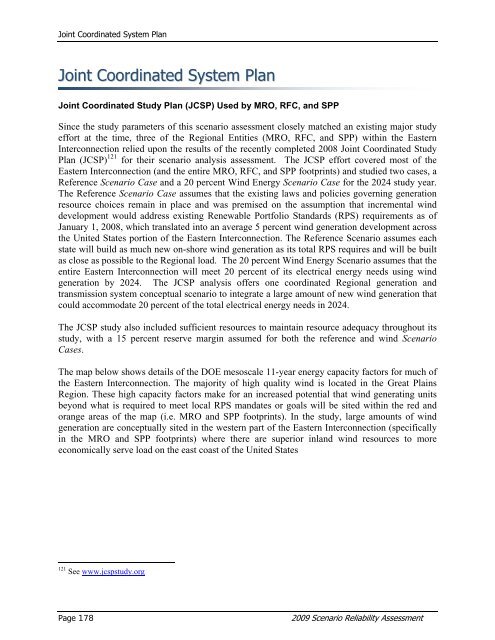2009 Scenario Reliability Assessment - NERC
2009 Scenario Reliability Assessment - NERC
2009 Scenario Reliability Assessment - NERC
- No tags were found...
Create successful ePaper yourself
Turn your PDF publications into a flip-book with our unique Google optimized e-Paper software.
Joint Coordinated System PlanJoint Coordinated System PlanJoint Coordinated Study Plan (JCSP) Used by MRO, RFC, and SPPSince the study parameters of this scenario assessment closely matched an existing major studyeffort at the time, three of the Regional Entities (MRO, RFC, and SPP) within the EasternInterconnection relied upon the results of the recently completed 2008 Joint Coordinated StudyPlan (JCSP) 121 for their scenario analysis assessment. The JCSP effort covered most of theEastern Interconnection (and the entire MRO, RFC, and SPP footprints) and studied two cases, aReference <strong>Scenario</strong> Case and a 20 percent Wind Energy <strong>Scenario</strong> Case for the 2024 study year.The Reference <strong>Scenario</strong> Case assumes that the existing laws and policies governing generationresource choices remain in place and was premised on the assumption that incremental winddevelopment would address existing Renewable Portfolio Standards (RPS) requirements as ofJanuary 1, 2008, which translated into an average 5 percent wind generation development acrossthe United States portion of the Eastern Interconnection. The Reference <strong>Scenario</strong> assumes eachstate will build as much new on-shore wind generation as its total RPS requires and will be builtas close as possible to the Regional load. The 20 percent Wind Energy <strong>Scenario</strong> assumes that theentire Eastern Interconnection will meet 20 percent of its electrical energy needs using windgeneration by 2024. The JCSP analysis offers one coordinated Regional generation andtransmission system conceptual scenario to integrate a large amount of new wind generation thatcould accommodate 20 percent of the total electrical energy needs in 2024.The JCSP study also included sufficient resources to maintain resource adequacy throughout itsstudy, with a 15 percent reserve margin assumed for both the reference and wind <strong>Scenario</strong>Cases.The map below shows details of the DOE mesoscale 11-year energy capacity factors for much ofthe Eastern Interconnection. The majority of high quality wind is located in the Great PlainsRegion. These high capacity factors make for an increased potential that wind generating unitsbeyond what is required to meet local RPS mandates or goals will be sited within the red andorange areas of the map (i.e. MRO and SPP footprints). In the study, large amounts of windgeneration are conceptually sited in the western part of the Eastern Interconnection (specificallyin the MRO and SPP footprints) where there are superior inland wind resources to moreeconomically serve load on the east coast of the United States121 See www.jcspstudy.orgPage 178<strong>2009</strong> <strong>Scenario</strong> <strong>Reliability</strong> <strong>Assessment</strong>
















